Effectiveness of Work-Integrated Learning Partnerships: Case Study of Cooperative Education in Agricultural Tertiary Education
Abstract
1. Introduction
2. Theoretical Framework
2.1. co-op Partnerships
2.2. Effectiveness of co-op Partnerships
2.3. Factors Influencing the Effectiveness of co-op Partnerships
2.3.1. Quality of the Program Design
2.3.2. Organizational Climate
2.3.3. Personal and Professional Qualities
3. Methodology
3.1. Study Design
3.2. Case Description
3.3. Sampling Procedure
3.4. Data Collection Instrument
3.5. Variable Measurement and Data Analysis
4. Results
4.1. Profile of the Respondents
4.2. Factors Influencing the Effectiveness of the co-op Program
4.2.1. Quality of Program Design
4.2.2. Personal and Professional Qualities
4.2.3. Organizational Climate
4.3. The Effectiveness of the co-op Program
4.4. Relationships between the Dimensions of the co-op Program and the Learning Outcomes
4.5. Differences in Effectiveness of the co-op Program according to Students’ GPAs
5. Discussion
5.1. Quality of the Program Design
5.2. Personal and Professional Qualities
5.3. Organizational Climate
5.4. Program Learning Outcomes
6. Conclusions
Author Contributions
Funding
Institutional Review Board Statement
Informed Consent Statement
Data Availability Statement
Conflicts of Interest
Appendix A
| Items | r |
|---|---|
| Q1 | 0.601 |
| Q2 | 0.673 |
| Q3 | 0.587 |
| Q4 | 0.677 |
| Q5 | 0.561 |
| Q6 | 0.581 |
| Q7 | 0.705 |
| Q8 | 0.533 |
| Q9 | 0.587 |
| Items | r |
|---|---|
| P1 | 0.544 |
| P2 | 0.539 |
| P3 | 0.577 |
| P4 | 0.621 |
| P5 | 0.619 |
| P6 | 0.543 |
| P7 | 0.603 |
| Items | r |
|---|---|
| O1 | 0.544 |
| O2 | 0.539 |
| O3 | 0.577 |
| O4 | 0.621 |
| O5 | 0.619 |
| O6 | 0.543 |
| O7 | 0.603 |
| O8 | 0.544 |
| O9 | 0.539 |
| O10 | 0.577 |
| O11 | 0.621 |
| O12 | 0.619 |
| O13 | 0.543 |
| O14 | 0.603 |
| O15 | 0.544 |
| O16 | 0.594 |
| Items | r |
|---|---|
| L1 | 0.591 |
| L2 | 0.507 |
| L3 | 0.618 |
| L4 | 0.622 |
| L5 | 0.624 |
| L6 | 0.629 |
| L7 | 0.611 |
| L8 | 0.598 |
| L9 | 0.582 |
| L10 | 0.633 |
| L11 | 0.640 |
| L12 | 0.613 |
| L13 | 0.567 |
| L14 | 0.559 |
| L15 | 0.622 |
| Items | Q1 | Q2 | Q3 | Q4 | Q5 | Q6 | Q7 | Q8 | Q9 |
|---|---|---|---|---|---|---|---|---|---|
| Q1 | 1.000 | ||||||||
| Q2 | 0.484 | 1.000 | |||||||
| Q3 | 0.392 | 0.311 | 1.000 | ||||||
| Q4 | 0.334 | 0.540 | 0.382 | 1.000 | |||||
| Q5 | 0.360 | 0.438 | 0.333 | 0.506 | 1.000 | ||||
| Q6 | 0.409 | 0.368 | 0.428 | 0.444 | 0.392 | 1.000 | |||
| Q7 | 0.522 | 0.574 | 0.554 | 0.517 | 0.488 | 0.412 | 1.000 | ||
| Q8 | 0.389 | 0.588 | 0.422 | 0.455 | 0.378 | 0.554 | 0.388 | 1.000 | |
| Q9 | 0.384 | 0.566 | 0.433 | 0.388 | 0.402 | 0.602 | 0.365 | 0.472 | 1.000 |
| Items | P1 | P2 | P3 | P4 | P5 | P6 | P7 |
|---|---|---|---|---|---|---|---|
| P1 | 1.000 | ||||||
| P2 | 0.602 | 1.000 | |||||
| P3 | 0.414 | 0.355 | 1.000 | ||||
| P4 | 0.384 | 0.487 | 0.363 | 1.000 | |||
| P5 | 0.465 | 0.427 | 0.373 | 0.386 | 1.000 | ||
| P6 | 0.302 | 0.422 | 0.449 | 0.508 | 0.402 | 1.000 | |
| P7 | 0.530 | 0.323 | 0.399 | 0.481 | 0.505 | 0.380 | 1.000 |
| O1 | O2 | O3 | O4 | O5 | O6 | O7 | O8 | O9 | O10 | O11 | O12 | O13 | O14 | O15 | O16 | |
|---|---|---|---|---|---|---|---|---|---|---|---|---|---|---|---|---|
| O1 | 1.000 | |||||||||||||||
| O2 | 0.352 | 1.000 | ||||||||||||||
| O3 | 0.602 | 0.451 | 1.000 | |||||||||||||
| O4 | 0.281 | 0.367 | 0.460 | 1.000 | ||||||||||||
| O5 | 0.303 | 0.424 | 0.321 | 0.529 | 1.000 | |||||||||||
| O6 | 0.504 | 0.268 | 0.473 | 0.425 | 0.602 | 1.000 | ||||||||||
| O7 | 0.516 | 0.372 | 0.511 | 0.456 | 0.525 | 0.337 | 1.000 | |||||||||
| O8 | 0.378 | 0.545 | 0.279 | 0.305 | 0.339 | 0.540 | 0.484 | 1.000 | ||||||||
| O9 | 0.422 | 0.527 | 0.505 | 0.278 | 0.471 | 0.321 | 0.533 | 0.392 | 1.000 | |||||||
| O10 | 0.307 | 0.415 | 0.347 | 0.444 | 0.452 | 0.508 | 0.609 | 0.534 | 0.288 | 1.000 | ||||||
| O11 | 0.522 | 0.428 | 0.564 | 0.596 | 0.432 | 0.447 | 0.558 | 0.430 | 0.385 | 0.323 | 1.000 | |||||
| O12 | 0.469 | 0.627 | 0.482 | 0.322 | 0.369 | 0.463 | 0.477 | 0.375 | 0.625 | 0.385 | 0.510 | 1.000 | ||||
| O13 | 0.533 | 0.355 | 0.662 | 0.434 | 0.528 | 0.321 | 0.326 | 0.684 | 0.547 | 0.364 | 0.302 | 0.320 | 1.000 | |||
| O14 | 0.422 | 0.620 | 0.637 | 0.329 | 0.442 | 0.364 | 0.508 | 0.422 | 0.317 | 0.536 | 0.389 | 0.266 | 0.362 | 1.000 | ||
| O15 | 0.295 | 0.441 | 0.345 | 0.513 | 0.541 | 0.579 | 0.412 | 0.329 | 0.346 | 0.304 | 0.412 | 0.596 | 0.346 | 0.403 | 1.000 | |
| O16 | 0.409 | 0.341 | 0.410 | 0.497 | 0.325 | 0.564 | 0.438 | 0.444 | 0.409 | 0.372 | 0.386 | 0.460 | 0.474 | 0.311 | 0.644 | 1.000 |
| L1 | L2 | L3 | L4 | L5 | L6 | L7 | L8 | L9 | L10 | L11 | L12 | L13 | L14 | L15 | |
|---|---|---|---|---|---|---|---|---|---|---|---|---|---|---|---|
| L1 | 1.000 | ||||||||||||||
| L2 | 0.544 | 1.000 | |||||||||||||
| L3 | 0.514 | 0.504 | 1.000 | ||||||||||||
| L4 | 0.590 | 0.468 | 0.421 | 1.000 | |||||||||||
| L5 | 0.519 | 0.528 | 0.492 | 0.545 | 1.000 | ||||||||||
| L6 | 0.547 | 0.589 | 0.658 | 0.379 | 0.623 | 1.000 | |||||||||
| L7 | 0.466 | 0.608 | 0.554 | 0.303 | 0.704 | 0.518 | 1.000 | ||||||||
| L8 | 0.427 | 0.587 | 0.388 | 0.340 | 0.552 | 0.597 | 0.458 | 1.000 | |||||||
| L9 | 0.507 | 0.536 | 0.369 | 0.362 | 0.447 | 0.636 | 0.436 | 0.588 | 1.000 | ||||||
| L10 | 0.501 | 0.425 | 0.504 | 0.381 | 0.463 | 0.678 | 0.388 | 0.566 | 0.328 | 1.000 | |||||
| L11 | 0.403 | 0.370 | 0.426 | 0.406 | 0.435 | 0.547 | 0.395 | 0.507 | 0.367 | 0.396 | 1.000 | ||||
| L12 | 0.422 | 0.552 | 0.466 | 0.477 | 0.383 | 0.507 | 0.478 | 0.605 | 0.472 | 0.467 | 0.384 | 1.000 | |||
| L13 | 0.398 | 0.505 | 0.462 | 0.429 | 0.428 | 0.469 | 0.605 | 0.621 | 0.451 | 0.508 | 0.657 | 0.438 | 1.000 | ||
| L14 | 0.384 | 0.566 | 0.433 | 0.388 | 0.402 | 0.602 | 0.365 | 0.472 | 0.365 | 0.365 | 0.365 | 0.365 | 0.365 | 1.000 | |
| L15 | 0.384 | 0.566 | 0.433 | 0.388 | 0.402 | 0.602 | 0.365 | 0.472 | 0.365 | 0.365 | 0.365 | 0.365 | 0.365 | 0.365 | 1.000 |
References
- Gül, H.; Gül, S.S.; Kaya, E.; Alican, A. Main trends in the world of higher education, internationalization and institutional autonomy. Procedia Soc. Behav. Sci. 2010, 9, 1878–1884. [Google Scholar] [CrossRef][Green Version]
- Paletta, A.; Fava, F.; Ubertini, F.; Bastioli, C.; Gregori, G.; la Camera, F.; Douvan, A.R. Universities, industries and sustainable development: Outcomes of the 2017 G7 Environment Ministerial Meeting. Sustain. Prod. Consum. 2019, 19, 1–10. [Google Scholar] [CrossRef]
- Rau, H.; Goggins, G.; Fahy, F. From invisibility to impact: Recognising the scientific and societal relevance of interdisciplinary sustainability research. Res. Policy 2018, 47, 266–276. [Google Scholar] [CrossRef]
- Lozano, R.; Lukman, R.; Lozano, F.J.; Huisingh, D.; Lambrechts, W. Declarations for sustainability in higher education: Becoming better leaders, through addressing the university system. J. Clean. Prod. 2013, 48, 10–19. [Google Scholar] [CrossRef]
- Hill, L.M.; Wang, D. Integrating sustainability learning outcomes into a university curriculum: A case study of institutional dynamics. Int. J. Sustain. High. Educ. 2018, 19, 699–720. [Google Scholar] [CrossRef]
- Kishita, Y.; Uwasu, M.; Hara, K.; Kuroda, M.; Takeda, H.; Umeda, Y.; Shimoda, Y. Toward designing sustainability education programs: A survey of master’s programs through semi-structured interviews. Sustain. Sci. 2018, 13, 953–972. [Google Scholar] [CrossRef]
- Dagiliūtė, R.; Liobikienė, G.; Minelgaitė, A. Sustainability at universities: Students’ perceptions from Green and Non-Green universities. J. Clean. Prod. 2018, 181, 473–482. [Google Scholar] [CrossRef]
- Berchin, I.I.; Sima, M.; de Lima, M.A.; Biesel, S.; dos Santos, L.P.; Ferreira, R.V.; de Andrade, J.B.S.O.; Ceci, F. The importance of international conferences on sustainable development as higher education institutions’ strategies to promote sustainability: A case study in Brazil. J. Clean. Prod. 2018, 171, 756–772. [Google Scholar] [CrossRef]
- Domingues, A.R.; Lozano, R.; Ceulemans, K.; Ramos, T.B. Sustainability reporting in public sector organisations: Exploring the relation between the reporting process and organisational change management for sustainability. J. Environ. Manag. 2017, 192, 292–301. [Google Scholar] [CrossRef]
- Lambrechts, W.; Ceulemans, K. Sustainability assessment in higher education: Evaluating the use of the auditing instrument for sustainability in higher education (AISHE) in Belgium. In Sustainability Assessment Tools in Higher Education Institutions; Springer: Berlin/Heidelberg, Germany, 2013; pp. 157–174. [Google Scholar]
- Hope, A. Creating sustainable cities through knowledge exchange: A case study of knowledge transfer partnerships. Int. J. Sustain. High. Educ. 2016, 17, 796–811. [Google Scholar] [CrossRef]
- Abramo, G.; d’Angelo, C.A.; di Costa, F. University-industry research collaboration: A model to assess university capability. High. Educ. 2011, 62, 163–181. [Google Scholar] [CrossRef]
- Franco, M.; Silva, R.; Rodrigues, M. Partnerships between higher education institutions and firms: The role of students’ curricular internships. Ind. High. Educ. 2019, 33, 172–185. [Google Scholar] [CrossRef]
- Ankrah, S.; Omar, A.-T. Universities–industry collaboration: A systematic review. Scand. J. Manag. 2015, 31, 387–408. [Google Scholar] [CrossRef]
- Navarro, R.A.; Barbarasa, E.; Thakkar, A. Addressing workforce needs by disrupting traditional industry–higher education relations: The case of El Salvador. Ind. High. Educ. 2019, 33, 391–402. [Google Scholar] [CrossRef]
- Cunningham, J.A.; Link, A.N. Fostering university-industry R&D collaborations in European Union countries. Int. Entrep. Manag. J. 2015, 11, 849–860. [Google Scholar]
- Orazbayeva, B.; Davey, T.; Plewa, C.; Galán-Muros, V. Engagement of academics in education-driven university-business cooperation: A motivation-based perspective. Stud. High. Educ. 2020, 45, 1723–1736. [Google Scholar] [CrossRef]
- Wardle, K.M. An Assessment of Work Integrated Learning (WIL) in Hospitality Tertiary Education. Ph.D. Thesis, University of Western Sydney Penrith, Sydney, Australia, 2014. [Google Scholar]
- Drewery, D.; Nevison, C.; Pretti, T.J. The influence of cooperative education and reflection upon previous work experiences on university graduates’ vocational self-concept. Educ. Train. 2016, 58, 179–192. [Google Scholar] [CrossRef]
- Fleming, J.; McLachlan, K.; Pretti, T.J. Successful Work-Integrated Learning Relationships: A Framework for Sustainability. Int. J. Work-Integr. Learn. 2018, 19, 321–335. [Google Scholar]
- Rast, S.; Khabiri, N.; Senin, A.A. Evaluation framework for assessing university-industry collaborative research and technological initiative. Procedia Soc. Behav. Sci. 2012, 40, 410–416. [Google Scholar] [CrossRef]
- Jackson, D. Employability skill development in work-integrated learning: Barriers and best practice. Stud. High. Educ. 2015, 40, 350–367. [Google Scholar] [CrossRef]
- Ibrahim, H.; Jaafar, A. The Outcomes of Work-Integrated Learning Programmes: The Role of Self-Confidence as Mediator between Interpersonal and Self-Management Skills and Motivation to Learn. Pertanika J. Soc. Sci. Humanit. 2017, 25, 931–948. [Google Scholar]
- Rambe, P. Using work integrated learning programmes as a strategy to broaden academic and workplace competencies. SA J. Hum. Resour. Manag. 2018, 16, 1–16. [Google Scholar] [CrossRef]
- Jovanovic, J.; Fane, J.; Andrew, Y. Giving institutional voice to work-integrated learning in academic workloads. Int. J. Work-Integr. Learn. 2018, 19, 93–109. [Google Scholar]
- Winchester-Seeto, T.; Rowe, A.; Mackaway, J. Sharing the load: Understanding the roles of academics and host supervisors in work-integrated learning. Asia-Pac. J. Coop. Educ. 2016, 17, 101–118. [Google Scholar]
- Rowe, A.; Mackaway, J.; Winchester-Seeto, T. ‘But I thought you were doing that’–Clarifying the role of the host supervisor in experience-based learning. Int. J. Work-Integr. Learn. 2012, 13, 115–134. [Google Scholar]
- Zha, Q.; Guangfen, Y.; Zhong, L. China’s university-industry partnership, cooperative education, and entrepreneurship education in a global context. Chin. Educ. Soc. 2016, 49, 115–120. [Google Scholar] [CrossRef]
- Fleming, J.; Hickey, C. Exploring Cooperative Education Partnerships: A Case Study in Sport Tertiary Education. Asia-Pac. J. Coop. Educ. 2013, 14, 209–221. [Google Scholar]
- Cord, B.; Clements, M. Pathway for student self-development: A learning orientated internship approach. Aust. J. Adult Learn. 2010, 50, 287–307. [Google Scholar]
- Morrison, I.V. The Experiences of International Students in Cooperative Education: A. Case Study. Master’s Thesis, The University of Regina, Regina, SK, Canada, 2013. [Google Scholar]
- Antwi, R.; Duncan, D.D.; Tsegah, M. Establishing Relevance through Cooperative Education in Ghana: A Study of Central University. Int. J. Work-Integr. Learn. 2019, 20, 271–281. [Google Scholar]
- Luekitinan, W. The Impact of Cooperative Education: Considering Employability and Career Advancement of New Graduates. Int. J. Inf. Educ. Technol. 2018, 8, 725–729. [Google Scholar] [CrossRef][Green Version]
- Gardner, P.; Bartkus, K.R. What’s in a Name? A Reference Guide to Work-Education Experiences. Asia-Pac. J. Coop. Educ. 2014, 15, 37–54. [Google Scholar]
- McRae, N.; Johnston, N. The development of a proposed global work-integrated learning framework. Asia-Pac. J. Coop. Educ. 2016, 17, 337–348. [Google Scholar]
- Rybnicek, R.; Königsgruber, R. What makes industry–university collaboration succeed? A systematic review of the literature. J. Bus. Econ. 2019, 89, 221–250. [Google Scholar] [CrossRef]
- Addy, E.; Adabor, E.S. Leadership roles and sustainable public–private partnership between technical universities and industry in Ghana. Tert. Educ. Manag. 2021, 27, 73–89. [Google Scholar] [CrossRef]
- Bajunaid, M.M. The Effectiveness of Co-Operative Education Programmes for Developing Students’ Awareness of the Importance of Generic Competencies. Ph.D. Thesis, University of Glasgow, Glasgow, UK, 2008. [Google Scholar]
- Jiang, Y.H.; Lee, S.W.Y.; Golab, L. Analyzing Student and Employer Satisfaction with Cooperative Education through Multiple Data Sources. Asia-Pac. J. Coop. Educ. 2015, 16, 225–240. [Google Scholar]
- Eames, C.; Coll, R.K. Cooperative education: Integrating classroom and workplace learning. In Learning through Practice; Billett, S., Ed.; Springer: Dordrecht, The Netherlands, 2010; pp. 180–196. [Google Scholar]
- Hsiung, C. The effectiveness of cooperative learning. J. Eng. Educ. 2012, 101, 119–137. [Google Scholar] [CrossRef]
- Aurandt, J.L.; Butler, E.C. Sustainability education: Approaches for incorporating sustainability into the undergraduate curriculum. J. Prof. Issues Eng. Educ. Pract. 2011, 137, 102–106. [Google Scholar] [CrossRef]
- Reichlmay, T.J. Collaborating with industry: Strategies for an undergraduate software engineering program. In Proceedings of the International Workshop on Summit on Software Engineering Education, Shanghai, China, 20–23 May 2006; pp. 13–16. [Google Scholar]
- Brahimi, N.; Dweiri, F.; al-Syouf, I.; Khan, S.A. Cooperative education in an industrial engineering program. Procedia Soc. Behav. Sci. 2013, 102, 446–453. [Google Scholar] [CrossRef][Green Version]
- Jimenez, M.; Nunez-Arzuaga, M. Implementing Irda on the Msp430: A project development under the undergraduate research/co-op education model. In Proceedings of the 34th Annual Frontiers in Education, Savannah, GA, USA, 20–23 October 2004; pp. 1–6. [Google Scholar]
- Liu, C.; Wang, Z.L.; Chen, J.L. Research on characteristics and models of China’s cooperative education. Appl. Mech. Mater. 2010, 33, 571–574. [Google Scholar] [CrossRef]
- Jimenez, M.; Palomera, R.; Toledo, M. Undergraduate research and co-op education: A winning combination. In Proceedings of the 32nd Annual Frontiers in Education, Boston, MA, USA, 6–9 November 2002; pp. S4C13–S4C17. [Google Scholar]
- Sovilla, E.; Varty, J. Cooperative education in the USA, past and present: Some lessons learned. In International Handbook for Cooperative Education: An International Perspective of the Theory, Research and Practice of Work-Integrated Learning; Coll, R.K., Eames, C., Eds.; World Association for Cooperative Education: Boston, MA, USA, 2004; pp. 3–16. [Google Scholar]
- Haddara, M.; Skanes, H. A reflection on cooperative education: From experience to experiential learning. Int. J. Work-Integr. Learn. 2007, 8, 67–76. [Google Scholar]
- Noyes, C.R.; Gordon, J.; Ludlum, J. The academic effects of cooperative education experiences: Does co-op make a difference in engineering coursework? In Proceedings of the ASEE Annual Conference & Exposition, Vancouver, BC, Canada, 26–29 June 2011; pp. 22.1428.1–22.1428.14. [Google Scholar]
- Hodson, D.; Hodson, J. From constructivism to social constructivism: A Vygotskian perspective on teaching and learning science. Sch. Sci. Rev. 1998, 79, 33–41. [Google Scholar]
- Trif, L. Training models of social constructivism. Teaching based on developing a scaffold. Procedia Soc. Behav. Sci. 2015, 180, 978–983. [Google Scholar] [CrossRef][Green Version]
- Friedrich, B.J. Factors Relating to Faculty Engagement in Cooperative Engineering Education. Ph.D. Thesis, Michigan State University, Lansing, MI, USA, 2011. [Google Scholar]
- Donohue, M.M. Transfer of Learning from the Classroom to the Cooperative Education Workplace in a Baccalaureate Program in an Ontario College of Applied Arts and Technology. Ph.D. Thesis, University of Toronto, Toronto, ON, Canada, 2010. [Google Scholar]
- Luo, J.M.; Chau, K.Y.; Lam, C.F.; Huang, G.Q.; Kou, I.T. Attitudes of undergraduate students from university–industry partnership for sustainable development: A case study in Macau. Sustainability 2018, 10, 1378. [Google Scholar] [CrossRef]
- Martin, A.; Fleming, J.; Ferkins, L.; Wiersma, C.; Coll, R.K. Facilitating and integrating learning within sport studies cooperative education: Exploring the pedagogies employed by students, academics and workplace supervisors. J. Hosp. Leis. Sport Tour. Education. 2010, 9, 24–38. [Google Scholar] [CrossRef]
- Naryan, R. Benefits of Cooperative Education: Student Perceptions at Manukau Institute of Technology. In Proceedings of New Zealand Association for Cooperative Education, Auckland, New Zealand, 20–21 April 2016; pp. 37–40. [Google Scholar]
- Ozek, H.Z. Impact of Internship Programme in Engineering Education. Eurasia Proc. Educ. Soc. Sci. 2018, 9, 276–283. [Google Scholar]
- Hodges, D.L. Assessment of Student Learning in a Business Internship. Ph.D. Thesis, The University of Waikato, Hamilton, New Zealand, 2010. [Google Scholar]
- Kassem, H.S.; Aljuaid, M.; Alotaibi, B.A.; Ghozy, R. Mapping and Analysis of Sustainability-Oriented Partnerships in Non-Profit Organizations: The Case of Saudi Arabia. Sustainability 2020, 12, 7178. [Google Scholar] [CrossRef]
- Kassem, H.S.; Bagadeem, S.; Alotaibi, B.A.; Aljuaid, M. Are partnerships in nonprofit organizations being governed for sustainability? A partnering life cycle assessment. PLoS ONE 2021, 16, e0249228. [Google Scholar] [CrossRef] [PubMed]
- Miller, M.U. The Value of Participating in Cooperative Education. Ph.D. Thesis, The University of Mississippi, Oxford, MS, USA, 2021. [Google Scholar]
- Ormord, J. Educational Psychology: Developing Learners; Merrill Prentice Hall: Hoboken, NJ, USA, 2008. [Google Scholar]
- Zegwaard, K.E.; Coll, R.K. Using Cooperative Education and Work-Integrated Education to Provide Career Clarification. Sci. Educ. Int. 2011, 22, 282–291. [Google Scholar]
- Richard, E.; Walter, R.; Yoder, E. The effect of capstone cooperative education experiences, and related factors, on career and technical education secondary student summative assessment scores. Career Tech. Educ. 2013, 38, 19–37. [Google Scholar] [CrossRef]
- Raelin, J.A.; Bailey, M.; Hamann, J.; Pendleton, L.; Raelin, J.; Reisberg, R.; Whitman, D. The effect of cooperative education on change in self-efficacy among undergraduate students: Introducing work self-efficacy. J. Coop. Educ. Internsh. 2011, 45, 17–35. [Google Scholar]
- Gardner, P.D.; Motschenbacher, G. Early Work Outcomes of Co-op and Non-co-op Engineers: A Comparison of Expectations, Job Level, and Salary. J. Coop. Educ. 1997, 33, 6–24. [Google Scholar]
- Blair, B.F.; Millea, M.; Hammer, J. The impact of cooperative education on academic performance and compensation of engineering majors. J. Eng. Educ. 2004, 93, 333–338. [Google Scholar] [CrossRef]
- Jackel, D. Evaluating the Effectiveness of an Internship Program. Master’s Thesis, Western Kentucky University, Bowling Green, KY, USA, 2011. [Google Scholar]
- Tennyson, R.; Gray, T.; Lobo, I. Emerging Opportunities for NGO-Business Partnerships: Feedback from the Cross-Sector Partnership Project; World Vision International: London, UK, 2008. [Google Scholar]
- Afansa, K.; Habte, D.; Hatfield, J.; Murphy, J.; Neufeld, V. Partnership Assessment Toolkit; Canadian Coalition for Global Health Research (CCGHR): Ottawa, ON, Canada, 2009. [Google Scholar]
- OECD LEED. Successful Partnerships: A Guide; Centre for Social Innovation (ZSI): Vienna, Austria, 2006. [Google Scholar]
- Wilson, J.W. Creating and Initiating a Cooperative Education Program; World Association for Cooperative Education: Boston, MA, USA, 1997. [Google Scholar]
- Stanley, M. Co-operative education: An effective educational strategy. J. New Gener. Sci. 2005, 3, 105–115. [Google Scholar]
- Dressler, S.; Keeling, A.E. Student benefits of cooperative education. In International Handbook for Cooperative Education: An International Perspective of the Theory, Research and Practice of Work-Integrated Learning; Coll, R.K., Eames, C., Eds.; World Association for Cooperative Education: Boston, MA, USA, 2004; pp. 217–236. [Google Scholar]
- Shanker, R.; Bhanugopan, R.; van der Heijden, B.I.; Farrell, M. Organizational climate for innovation and organizational performance: The mediating effect of innovative work behavior. J. Vocat. Behav. 2017, 100, 67–77. [Google Scholar] [CrossRef]
- Martins, N.; von der Ohe, H. Organisational climate measurement-new and emerging dimensions during a period of transformation. S. Afr. J. Labour Relat. 2003, 27, 41–59. [Google Scholar]
- Kundu, K. Development of the conceptual framework of organizational climate. Vidyasagar Univ. J. Commer. 2007, 12, 99–108. [Google Scholar]
- Datta, A.; Singh, R. Determining the dimensions of organizational climate perceived by the hotel employees. J. Hosp. Tour. Manag. 2018, 36, 40–48. [Google Scholar] [CrossRef]
- Berberoglu, A. Impact of organizational climate on organizational commitment and perceived organizational performance: Empirical evidence from public hospitals. BMC Health Serv. Res. 2018, 18, 1–9. [Google Scholar] [CrossRef] [PubMed]
- Gruzdev, M.V.; Kuznetsova, I.V.; Tarkhanova, I.Y.; Kazakova, E.I. University Graduates’ Soft Skills: The Employers’ Opinion. Eur. J. Contemp. Educ. 2018, 7, 690–698. [Google Scholar]
- Hadiyanto, H.; Noferdiman, N.; Moehamin, M.; Yuliusman, Y. Assessing Students and Graduates Soft Skills, Hard Skills and Competitiveness. PEOPLE Int. J. Soc. Sci. 2017, 3, 1885–1906. [Google Scholar]
- Radermacher, A.; Walia, G.; Knudson, D. Investigating the skill gap between graduating students and industry expectations. In Proceedings of the Companion Proceedings of the 36th International Conference on Software Engineering, Hyderabad, India, 31 May–7 June 2014; pp. 291–300. [Google Scholar]
- Bridgstock, R. The graduate attributes we’ve overlooked: Enhancing graduate employability through career management skills. High. Educ. Res. Dev. 2009, 28, 31–44. [Google Scholar] [CrossRef]
- Tham, P.; Lynch, D. Prepared for practice? Graduating social work students’ reflections on their education, competence and skills. Soc. Work. Educ. 2014, 33, 704–717. [Google Scholar] [CrossRef]
- Nagarajan, S.; Edwards, J. The Role of Universities, Employers, Graduates and Professional Associations in the Development of Professional Skills of New Graduates. J. Perspect. Appl. Acad. Pract. 2015, 3, 26–37. [Google Scholar]
- Crebert, G.; Bates, M.; Bell, B.; Patrick, C.J.; Cragnolini, V. Developing generic skills at university, during work placement and in employment: Graduates’ perceptions. High. Educ. Res. Dev. 2004, 23, 147–165. [Google Scholar] [CrossRef]
- Selvadurai, S.; Choy, E.A.; Maros, M. Generic skills of prospective graduates from the employers’ perspectives. Asian Soc. Sci. 2012, 8, 295–303. [Google Scholar] [CrossRef]
- Anjum, S. Impact of internship programs on professional and personal development of business students: A case study from Pakistan. Future Bus. J. 2020, 6, 1–13. [Google Scholar] [CrossRef]
- Tynjälä, P. Perspectives into learning at the workplace. Educ. Res. Rev. 2008, 3, 130–154. [Google Scholar] [CrossRef]
- Merriam, S.B. Qualitative Research and Case Study Applications in Education; Jossey-Bass: San Francisco, CA, USA, 1998. [Google Scholar]
- Stake, R.E. The Art of Case Study Research; Sage: Thousand Oaks, CA, USA, 1995. [Google Scholar]
- Bryman, A. Social Research Methods, 5th ed.; Oxford University Press: New York, NY, USA, 2016. [Google Scholar]
- CFAS. Cooperative Education Guide; College of Food and Agriculture Sciences (CFAS), King Saud University: Riyadh, Saudi Arabia, 2018. [Google Scholar]
- CFAS. Academic Requirements for Registration in Cooperative Education; College of Food and Agriculture Sciences, King Saud University: Riyadh, Saudi Arabia, 2018. [Google Scholar]
- Wim, J.; Katrien, W.; Patrick, D.P.; Patrick, V.K. Marketing Research with SPSS; Prentice Hall: Hoboken, NJ, USA, 2008. [Google Scholar]
- Robinson, M.A. Using multi-item psychometric scales for research and practice in human resource management. Hum. Resour. Manag. 2018, 57, 739–750. [Google Scholar] [CrossRef]
- Government of Kingdom of Saudi Arabia. National Transformation Program Delivery Plan 2018–2020; Government of Kingdom of Saudi Arabia: Riyadh, Saudi Arabia, 2018. [Google Scholar]
- Nurhadi, D.; Wu, M.; Sudjimat, D.A. Developing partnership program between polytechnic and industry in the remote area: A strategy to improve graduates quality. Int. J. Innov. Appl. Stud. 2016, 17, 1125–1131. [Google Scholar]
- Dang, J.; King, K.M.; Inzlicht, M. Why are self-report and behavioral measures weakly correlated? Trends Cogn. Sci. 2020, 24, 267–269. [Google Scholar] [CrossRef]
- Park, N.K.; Chun, M.Y.; Lee, J. Revisiting individual creativity assessment: Triangulation in subjective and objective assessment methods. Creat. Res. J. 2016, 28, 1–10. [Google Scholar] [CrossRef]
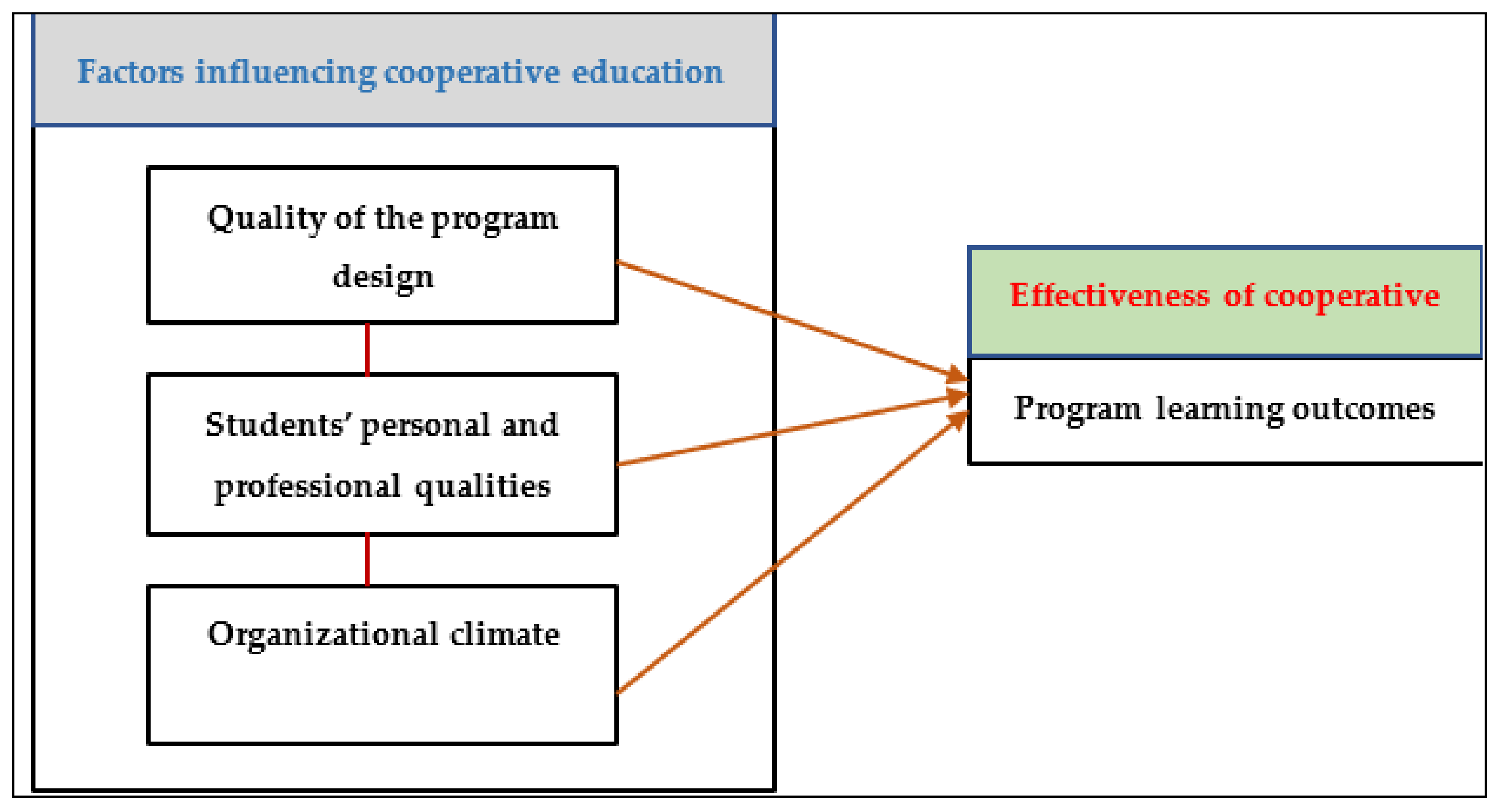
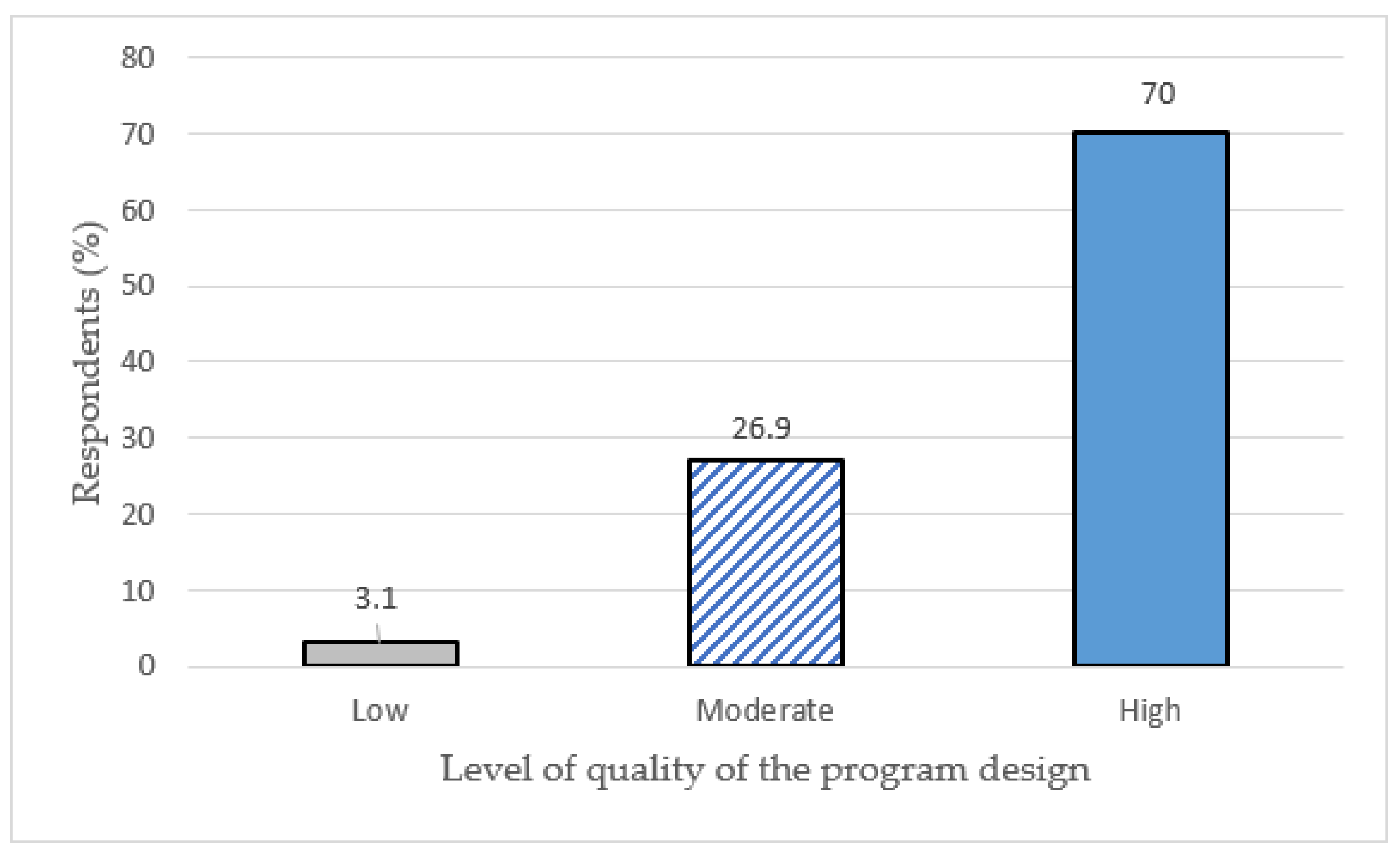
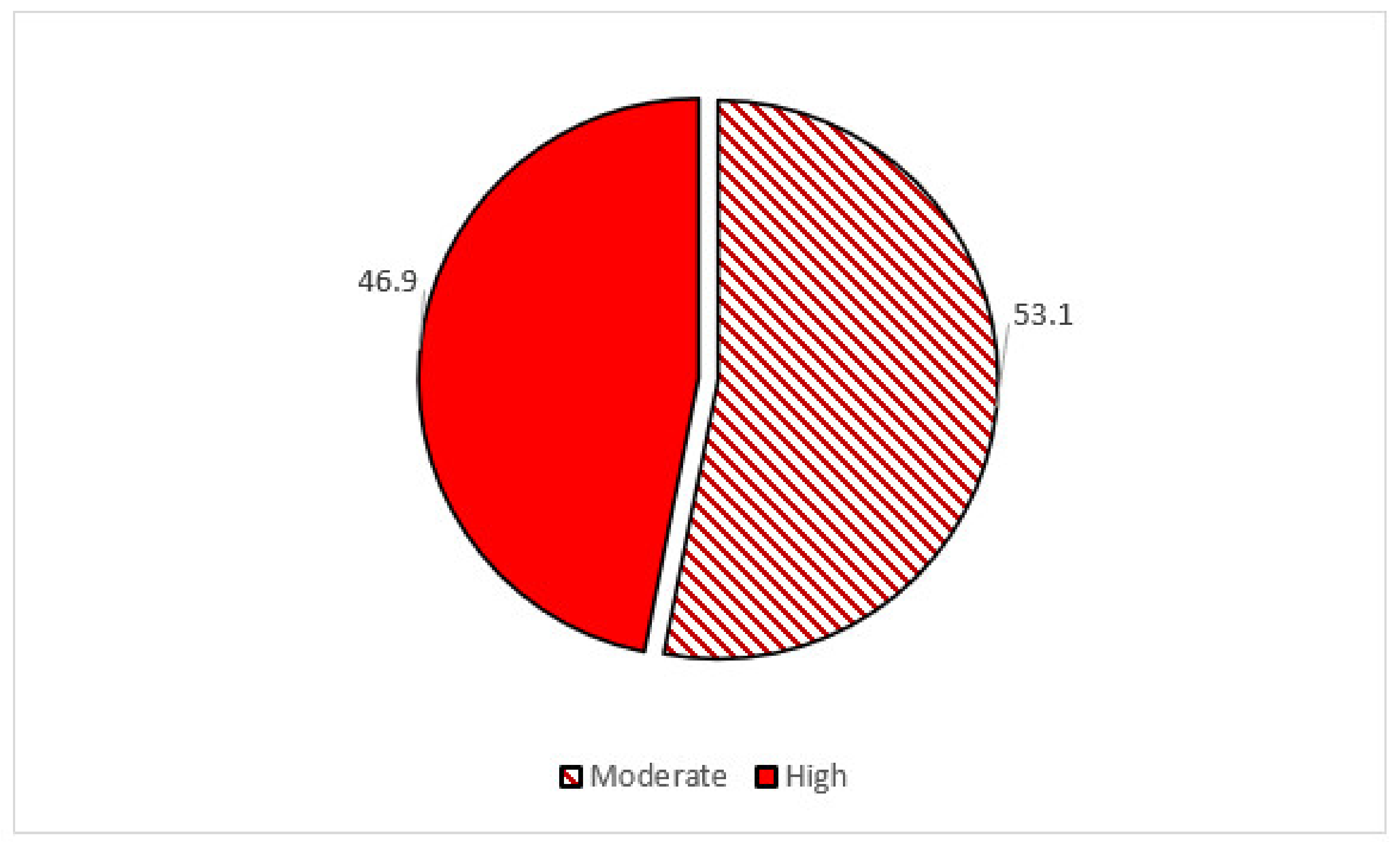
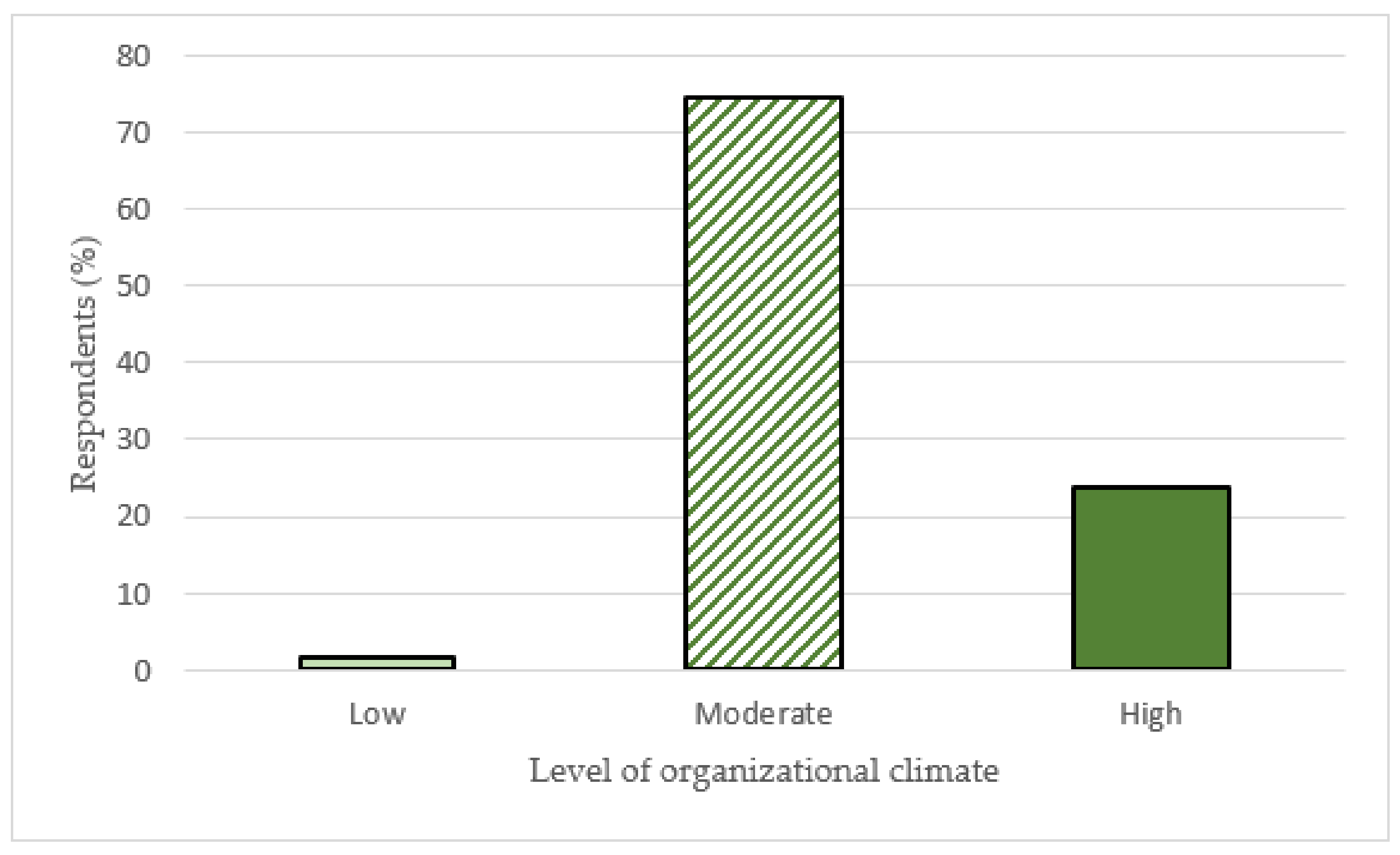
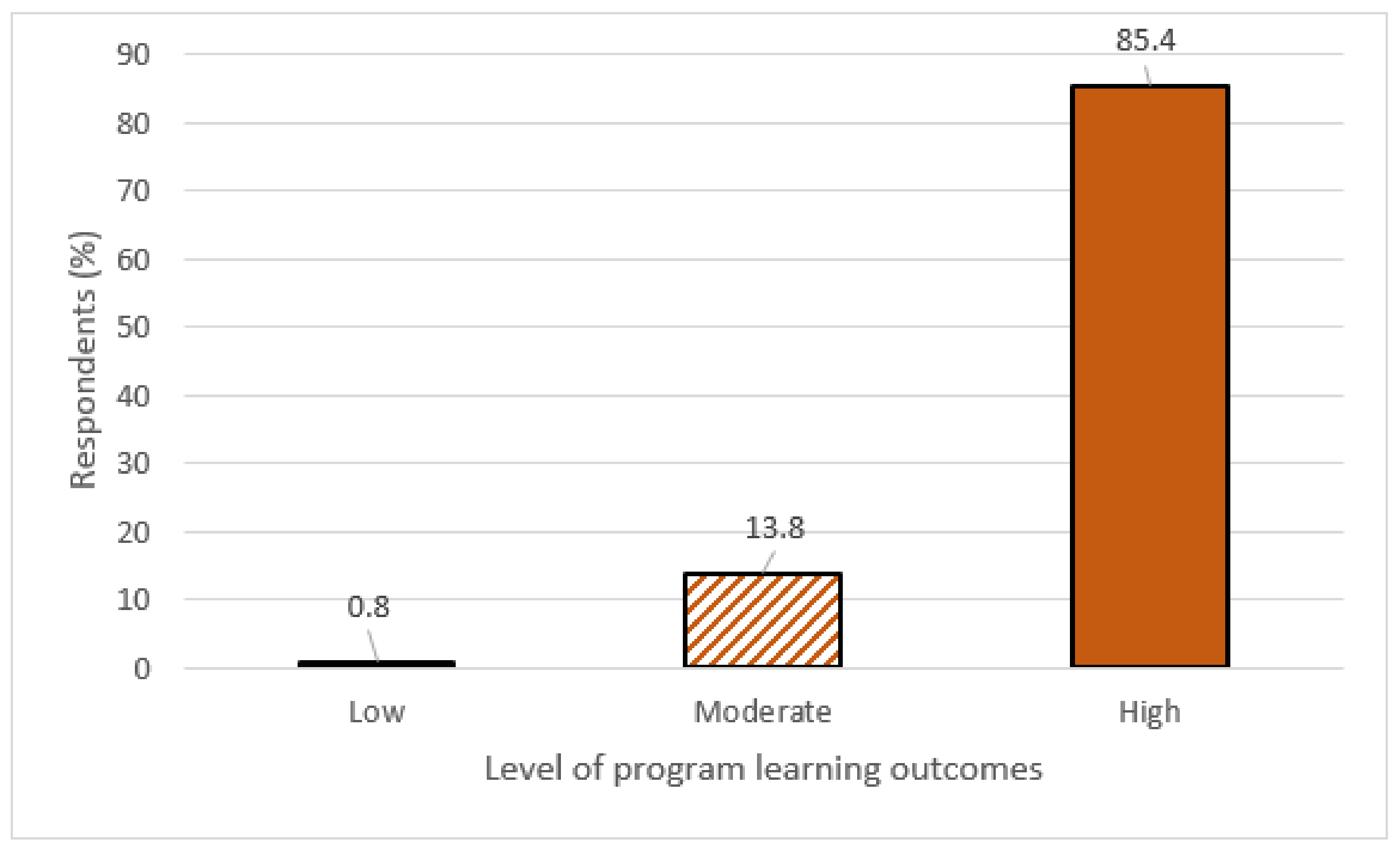
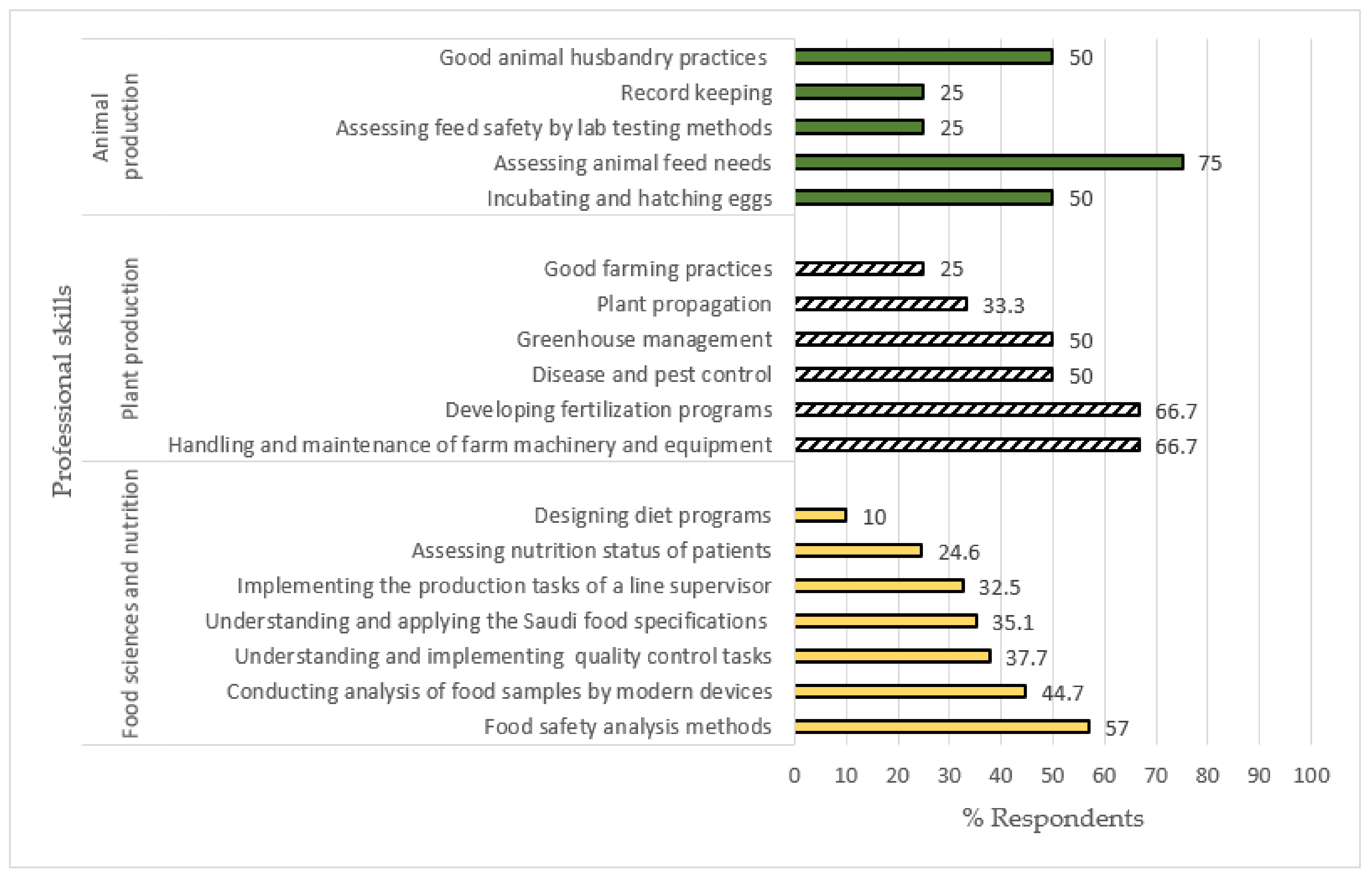
| Variable | Number of Students = 130 | |
|---|---|---|
| Frequency | Percentage | |
| Major | ||
| Food science and nutrition | 114 | 87.7 |
| Plant production | 12 | 9.2 |
| Animal production | 4 | 3.1 |
| Grade level | ||
| Seven | 17 | 13.1 |
| Eight | 113 | 86.9 |
| Age (years) (min. = 21, max. = 26, mean = 23.09, SD = 1.75) | ||
| Younger than 22 | 35 | 26.9 |
| 22 | 58 | 44.6 |
| 23 | 21 | 16.2 |
| Older than 23 | 16 | 12.3 |
| Grade point average (GPA) (min. = 2.33, max. = 4.76, mean = 3.47, SD = 0.69) | ||
| Less than 3 | 30 | 23.1 |
| 3–4 | 78 | 60 |
| More than 4 | 22 | 16.9 |
| Host organization * (sum = 260) | ||
| Hospitals (civil and private) | 87 | 33.5 |
| Laboratories (civil and private) | 27 | 10.4 |
| Food companies | 114 | 43.8 |
| Plant production companies | 24 | 9.2 |
| Animal production and manufacturing industry | 8 | 3.1 |
| Quality Items (Q) | Mean | SD | |
|---|---|---|---|
| Q1 | The design of the co-op program was aligned with my educational needs. | 4.38 | 0.8 |
| Q2 | A co-op program was conducted in more than one entity to ensure a diversity of experiences. | 4.12 | 1.07 |
| Q3 | The criteria by which students are evaluated were announced and clarified before beginning the co-op program. | 4.08 | 1.01 |
| Q4 | The training contents were designed based on the training objectives. | 3.76 | 0.96 |
| Q5 | The assessment of the co-op program was based on the acquired knowledge and skills. | 3.92 | 0.68 |
| Q6 | The co-op program was carried out in more than one department within the entity joined. | 3.92 | 1.1 |
| Q7 | Evaluation of the co-op included measuring the most important strengths and weaknesses. | 3.88 | 1.02 |
| Q8 | Student expectations and concerns were discussed before formulating training objectives. | 3.88 | 1.1 |
| Q9 | The training period in the entity was sufficient for practical benefit. | 3.22 | 1.3 |
| Overall mean | 3.89 | 0.98 |
| Personal and Professional Items (P) | Mean | SD | |
|---|---|---|---|
| P1 | I felt more motivated to gain the knowledge and skills required during the training period. | 4.51 | 0.68 |
| P2 | I was serious and disciplined during the training period in the entity. | 4.3 | 0.66 |
| P3 | I felt proud and honored to be trained in agricultural agencies related to my specialization. | 4.23 | 0.93 |
| P4 | I handled the pressure at work effectively. | 3.48 | 1.2 |
| P5 | I dealt professionally with difficult personalities in the workplace environment. | 3.56 | 1.2 |
| P6 | The courses delivered at the college assisted in improving my understanding of some aspects of the work in the entity I joined. | 3.07 | 0.86 |
| P7 | My level of English language proficiency allowed me to do tasks effectively and facilitated my communication with the employees in the entity. | 2.73 | 1.3 |
| Overall mean | 3.69 | 1.03 |
| Organizational Climate Items (O) | Mean | SD | |
|---|---|---|---|
| B1. College | |||
| O1 | The college conducted a periodic follow-up in the workplace. | 4.08 | 1.02 |
| O2 | The college provided a preparatory course to introduce the co-op before starting it. | 4.1 | 1.18 |
| O3 | The administration supported my requests regarding the co-op program. | 3.83 | 1.04 |
| O4 | I could choose the training locations according to my preferences. | 2.82 | 1.3 |
| O5 | Clear objectives that should be achieved by the end of co-op program were set. | 2.66 | 1.1 |
| B2. Host organization | |||
| O6 | My co-workers treated me with respect and appreciation. | 4.5 | 0.7 |
| O7 | The entity conducted a periodic follow-up for students in the workplace. | 4.22 | 0.9 |
| O8 | I got a certificate after finishing the co-op program. | 4.08 | 1.2 |
| O9 | A business card was quickly issued. | 3.98 | 1.2 |
| O10 | I was treated as an employee in the entity with specific powers. | 3.8 | 1.08 |
| O11 | Convenient places were available for me in the entity that I joined. | 3.25 | 1.3 |
| O12 | The coaching body gave me the confidence to perform the tasks without a supervisor. | 2.81 | 1.3 |
| O13 | The entity allowed me to be trained in various departments within the entity. | 2.67 | 1.2 |
| O14 | Managers empowered, motivated, and valued employee suggestions. | 2.57 | 1.3 |
| O15 | The entity allowed for the filming and photographing of technical tasks during the training period. | 2.45 | 1.2 |
| O16 | The working hours were representative of life in the agriculture industry. | 3.55 | 0.88 |
| Overall mean | 3.15 | 1.12 |
| Learning Outcomes Items (L) | Mean | SD | |
|---|---|---|---|
| L1 | I could rely on myself to perform the job duties. | 4.43 | 0.58 |
| L2 | I got high satisfaction from the supervisors about the assigned job tasks. | 4.39 | 0.76 |
| L3 | I acquired new ways and methods for solving technical and non-technical business problems. | 4.38 | 0.57 |
| L4 | I developed communication skills with my colleagues. | 4.34 | 0.66 |
| L5 | I learned about future work patterns in the field of specialization and job requirements. | 4.33 | 0.71 |
| L6 | I increased my knowledge of quality systems and standards. | 4.32 | 0.71 |
| L7 | I learned how to make non-routine decisions in the work environment. | 4.32 | 0.88 |
| L8 | I improved my report-writing skills. | 4.29 | 0.78 |
| L9 | I learned appropriate decision-making skills for different business problems. | 4.28 | 0.69 |
| L10 | I developed time-management skills. | 4.28 | 0.79 |
| L11 | I increased my interest in the educational material in my major. | 4.27 | 0.82 |
| L12 | I improved my understanding of the courses to a large extent. | 4.24 | 0.89 |
| L13 | I understand safety regulations and professional standards. | 4.25 | 0.79 |
| L14 | I enhanced my learning by integrating theory and practice. | 4.25 | 0.81 |
| L15 | I am familiar with modern techniques and technology used in the field of work. | 4.15 | 0.76 |
| Overall mean | 4.3 | 0.74 |
| Construct | Satisfaction of Program Learning Outcomes | |
|---|---|---|
| r | p-Value | |
| Quality of the program design | 0.58 ** | 0.00 |
| Personal and professional qualities | 0.38 ** | 0.00 |
| Organizational climate | 0.54 ** | 0.00 |
| Sum of Squares | df | Mean Square | F | p-Value | |
|---|---|---|---|---|---|
| Between groups | 535.73 | 2 | 267.866 | 2.79 | 0.065 |
| Within groups | 11,320.371 | 118 | 95.935 | ||
| Total | 11,856.103 | 120 |
Publisher’s Note: MDPI stays neutral with regard to jurisdictional claims in published maps and institutional affiliations. |
© 2021 by the authors. Licensee MDPI, Basel, Switzerland. This article is an open access article distributed under the terms and conditions of the Creative Commons Attribution (CC BY) license (https://creativecommons.org/licenses/by/4.0/).
Share and Cite
Kassem, H.S.; Al-Zaidi, A.A.; Baessa, A. Effectiveness of Work-Integrated Learning Partnerships: Case Study of Cooperative Education in Agricultural Tertiary Education. Sustainability 2021, 13, 12684. https://doi.org/10.3390/su132212684
Kassem HS, Al-Zaidi AA, Baessa A. Effectiveness of Work-Integrated Learning Partnerships: Case Study of Cooperative Education in Agricultural Tertiary Education. Sustainability. 2021; 13(22):12684. https://doi.org/10.3390/su132212684
Chicago/Turabian StyleKassem, Hazem S., Abdullah Awad Al-Zaidi, and Awadh Baessa. 2021. "Effectiveness of Work-Integrated Learning Partnerships: Case Study of Cooperative Education in Agricultural Tertiary Education" Sustainability 13, no. 22: 12684. https://doi.org/10.3390/su132212684
APA StyleKassem, H. S., Al-Zaidi, A. A., & Baessa, A. (2021). Effectiveness of Work-Integrated Learning Partnerships: Case Study of Cooperative Education in Agricultural Tertiary Education. Sustainability, 13(22), 12684. https://doi.org/10.3390/su132212684







